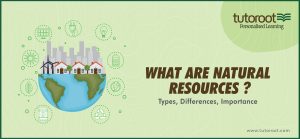What are Natural Resources? – Types, Difference, Importance 2024

As the title itself states, natural resources are available all across the world, each offering a different function or benefit. If you want to learn more about these Natural Resources, then you are in the right place. As here in the article below, we are going to provide a detailed description of Natural Resources, classification of natural resources, types of resources, their differences, and many more.
What are Natural Resources?
Firstly, the resources that already exist on planet earth or are formed without any intervention of humans, are called Natural Resources. For instance, popular examples of natural resources are Plants, Soil, Air, Water, Fossil Fuels, and many more. These natural resources are very essential for us humans, as they offer multiple benefits, like that of fossil fuels that are actively used in transportation and electricity generation.
Types of Natural Resources
Now, here in this section, we are going to talk briefly about the different types of natural resources, as well as provide some examples of them. Firstly, natural resources are categorized into two types, renewable and non-renewable resources.
-
Renewable Resources
The resources which are not limited and can be actively used repeatedly for multiple purposes are classified as renewable resources.
-
Non-Renewable Resources
Unlike renewable resources, these resources are limited, which means they cannot be renewed, as they run out of abundance in the coming years.
Explore Natural Resources in Detail With this Video. Watch now and learn more.
Importance of the Natural Resources
As we have already covered the Natural Resources and their types. Let us now discuss the importance of natural resources, and why we must take initiative to conserve them instead of overusing them.
- Various Natural Resources that come out of forests such as wood, can be actively used for many purposes, for making furniture, etc.
- While plants and animals across the ecosystem, also provide us with shelter as well as food.
- Natural Resources from various plants also consist of multiple medicinal properties which is why they are actively used in the healthcare industry.
- Besides, this, other resources like coal, and petroleum, are used for transportation as well as in the generation of electricity as stated above.
- Moreover, solar energy, wind, and tidal energy are other forms of natural resources that are also used for electricity generation.
- Water bodies play a very important role in humans’ day-to-day needs as they are used for the fishing industry, transportation across continents, as well as, for agriculture.
- Other non-renewable resources like gold and diamonds are generally used in the jewelry industry, and also have decoration.
- Furthermore, other minerals, metals, and chemicals played an active role in industrialization, which led to urbanization across the world.
Difference Between Renewable and Non-Renewable Resources
There are multiple differences between Renewable and Non-Renewable resources which we list here in this section.
| Parameters | Renewable Resources | Non-Renewable Resources |
| Renewable | These resources as the name suggests, are renewable as they are abundant of them. | While the non-renewable resources are limited, which means they cannot be renewed. |
| Type of Nature | Renewable resources are sustainable in nature. | While the non-renewable resources are exhaustible in nature. |
| Expense | Renewable resources are cost-effective. | And the non-renewable resources are very expensive. |
| Effects on Environment | Environment Friendly. | Harmful to Environment. |
| Abundance | These resources are available in abundance, and thus can be replenished easily. | While these resources are limited and cannot be replenished. |
Examples of Natural Resources
There are many natural resources all around us, offering various benefits or uses for humans, as well as other species in the ecosystem. Some examples of these resources are,
- Water is a very important resource for all life on earth and it is available in abundance, as 70% of our planet’s surface is filled with water.
- Soil is generally composed of multiple nutrients, vitamins, and minerals which play a major role in the growth of various plants, and herbs, which in turn can be used by humans for different purposes.
- Forests are ecosystems that thrive with various flora and fauna and are essentially the sources of clean air, wood, medicinal herbs, and many more.
- Iron is one of the most used natural resources across the world, as it has many applications such as buildings, transportation as well as weapons.
- Air is another natural resource that is abundant in nature, which helps all forms of life species survive here on planet earth.
Conclusion
In the article above, we helped you understand all about Natural Resources, the classification of natural resources, types of resources, and natural resources examples. If you want to learn more about any other interesting topics in physics, or having any trouble understanding the concepts. Then it would be a good idea for you to join the Online Interactive Classes offered by the Tutoroot platform, and access the various benefits offered through this program.
Frequently Asked Questions
How many types of natural resources exists?
As explained in the above article, natural resources are categorized into two types, renewable and non-renewable resources.
